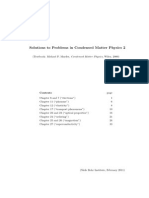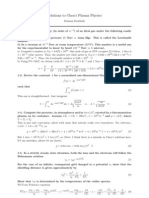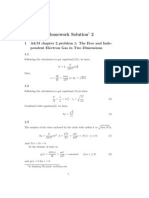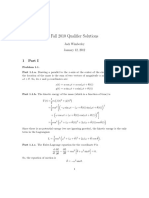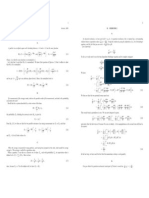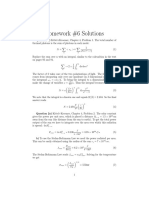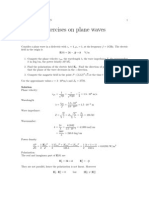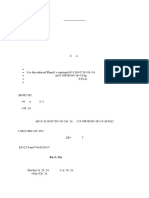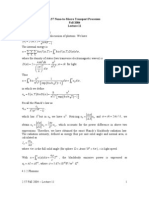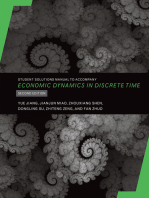PHZ6426: Fall 2013 Problem Set # 6: Electron Transport. Phonons. Due Monday, 12/02 at The Time of The Class Instructor: D. L. Maslov Maslov@phys - Ufl.edu 392-0513 Rm. 2114 Office Hours: TR 3 pm-4 PM
PHZ6426: Fall 2013 Problem Set # 6: Electron Transport. Phonons. Due Monday, 12/02 at The Time of The Class Instructor: D. L. Maslov Maslov@phys - Ufl.edu 392-0513 Rm. 2114 Office Hours: TR 3 pm-4 PM
Uploaded by
Mkt SchrbrCopyright:
Available Formats
PHZ6426: Fall 2013 Problem Set # 6: Electron Transport. Phonons. Due Monday, 12/02 at The Time of The Class Instructor: D. L. Maslov Maslov@phys - Ufl.edu 392-0513 Rm. 2114 Office Hours: TR 3 pm-4 PM
PHZ6426: Fall 2013 Problem Set # 6: Electron Transport. Phonons. Due Monday, 12/02 at The Time of The Class Instructor: D. L. Maslov Maslov@phys - Ufl.edu 392-0513 Rm. 2114 Office Hours: TR 3 pm-4 PM
Uploaded by
Mkt SchrbrOriginal Description:
Original Title
Copyright
Available Formats
Share this document
Did you find this document useful?
Is this content inappropriate?
Copyright:
Available Formats
PHZ6426: Fall 2013 Problem Set # 6: Electron Transport. Phonons. Due Monday, 12/02 at The Time of The Class Instructor: D. L. Maslov Maslov@phys - Ufl.edu 392-0513 Rm. 2114 Office Hours: TR 3 pm-4 PM
PHZ6426: Fall 2013 Problem Set # 6: Electron Transport. Phonons. Due Monday, 12/02 at The Time of The Class Instructor: D. L. Maslov Maslov@phys - Ufl.edu 392-0513 Rm. 2114 Office Hours: TR 3 pm-4 PM
Uploaded by
Mkt SchrbrCopyright:
Available Formats
PHZ6426: Fall 2013
Problem set # 6: Electron Transport. Phonons.
due Monday, 12/02 at the time of the class
Instructor: D. L. Maslov
maslov@phys.u.edu 392-0513 Rm. 2114
Oce hours: TR 3 pm-4 pm
Please help your instructor by doing your work neatly. Every (algebraic) nal result
must be supplemented by a check of units. Without such a check, no more
than 75% of the credit will be given even for an otherwise correct solution.
. . .
P1 [20 points ]Hall conductivity of Bloch electrons
In class, we derived a general formula for the Hall conductivity in the weak-eld regime (
c
1)
xy
= 2e
3
2
B
c
_
d
D
k
(2)
D
v
x
_
v
y
1
m
yx
v
x
1
m
yy
__
f
0
_
,
where D is the dimensionality,
v
a
=
1
k
k
,
1
m
=
1
k
k
,
and f
0
is the equilibrium Fermi function.
a) Show that
xy
= 0
at T = 0 for a half-lled tight-binding band corresponding to a 2D square lattice with dispersion
k
= 2t [cos (k
x
a) + cos (k
y
a)] .
[10 points]
Solution
Since the o-diagonal term in the eective mass tensor is absent, we have at T = 0,
xy
= 2e
3
2
B
_
d
D
k
(2)
D
v
2
x
1
m
yy
(
F
k
) = 2e
3
2
B
_
dA
v
2
x
|v
F
| m
yy
. (1)
where the integral goes over the Fermi surface, |v
F
| is the magnitude of the velocity evaluated on the Fermi
surface, and
1
m
yy
=
1
k
k
2
y
=
2ta
2
2
cos (k
y
a)
v
x
=
1
k
k
x
=
2ta
sin (k
x
a)
The Fermi surface at half-lling in 2D is shown in Fig. 1 (red). Consider segment I on which k
y
= /ak
x
.
The contribution of the segment to the integral in (1)
xy
I
= 2e
3
2
B
_
/a
0
dk
x
sin
2
k
x
a
|v
F
|
cos
__
a
k
x
_
a
_
= 2e
3
2
B
_
/a
0
dk
x
sin
2
k
x
a
|v
F
|
cos(k
x
a).
I
II III
IV
FIG. 1: The Brillouin zone (black) and Fermi surface at half-lling (red) for a 2D tight-binding model on a square lattice.
Wavenumbers are measured in units of 1/a.
Since cosine is odd in the interval (0, /a) , while the rest of the integrand is even, the integral vanishes.
Same is true for the remaining segments II IV.
b) Find
xy
at T = 0 for electrons (
F
> 0) and holes (
F
< 0) in graphene, using the Dirac model for
the spectrum
k
= v
F
k. [10 points] [Beware: although the spectrum is isotropic, the o-diagonal
components of the eective mass tensor are not equal to zero!]
Solution
Since the Dirac spectrum is isotropic, it is more convenient to keep the 2D integral over k in its original
form. Choosing the electron branch of the spectrum, = v
F
k and putting T to zero,
xy
= 2e
3
2
B
_
d
2
k
(2)
2
v
x
_
v
y
1
m
xy
v
x
1
m
yy
_
(v
F
k
F
) .
Derivatives
v
x
=
1
k
k
x
= v
F
k
x
k
v
y
=
1
k
k
y
= v
F
k
y
k
1
m
xy
=
1
k
k
x
k
y
=
v
F
k
k
x
k
y
k
2
1
m
yy
=
v
F
k
_
1
k
2
y
k
2
_
v
x
_
v
y
1
m
xy
v
x
1
m
yy
_
= v
F
k
x
k
_
v
F
k
y
k
v
F
k
k
x
k
y
k
2
v
F
k
x
k
v
F
k
_
1
k
2
y
k
2
__
=
v
3
F
k
2
x
k
3
=
v
3
F
k
cos
2
.
xy
= 2e
3
2
B
_
dkk
(2)
2
v
3
F
k
(v
F
k
F
)
_
2
0
dcos
2
= 2e
3
2
B
_
dkk
(2)
2
v
3
F
k
(v
F
k
F
) = 2e
3
2
B
1
(2)
2
v
3
F
2
v
F
=
1
2
2
e
3
2
Bv
2
F
.
Using the result of the Problem 1 for the cyclotron mass in graphene m
c
=
F
/v
2
F
and the expression
for the conductivity
0
= e
2
F
v
2
F
/2 with
F
=
F
/
2
v
2
F
at B = 0, we see that
xy
=
c
0
with
c
= eB/m
c
(SI units).
For
F
< 0, one has to choose the hole branch of the spectrum
k
= v
F
k. Since the integrand is
proportional to the third power of
k
, the sign of the
xy
changes.
P2 [25 points ] Consider an electron gas described by the Maxwell-Boltzmann statistics in the presence of an elastic scattering
mechanism with an energy dependent relaxation time () = A/
s
. Using the relaxation-time approximation
for the Boltzmann equation, show that the Wiedemann-Franz ratio is given by
T
=
_
5
2
s
__
k
B
e
_
2
, (2)
where and are the thermal and charge conductivities, correspondingly.
1
Solution
Suppose that we apply both the electric eld and the temperature gradient. Then the Boltzmann equation in
the relaxation time approximation reads
v f e (v E)
f
0
=
f f
0
()
.
I assume here that may depend on the electron energythis will be important for obtaining the numerical
factor in Eq. (2). In the presence of the temperature gradient, the distribution function in the gradient term is
an equilibrium function of the combination ( (r))/T (r)
f = f
0
_
(r)
k
B
T (r)
_
.
Note that the chemical potential in general depends on the temperature and, thus, on r. For small gradients,
f =
k
B
T
2
f
0
T
k
B
T
f
0
where T = const and = const everywhere but inside the gradient trims. Using
f
0
=
1
k
B
T
f
0
,
we re-write f as
f =
T
T
f
0
f
0
,
so that the Boltzmann equation becomes
T
vT
f
0
ev E
f
0
=
f f
0
()
where E
= E+/e is the eective electric eld. Actually, measurement of the electric current involves a
contact between two metals, so that the gradient of the chemical potential must always be added to the electric
eld. Then the electrical conductivity measures the response to an eective eld E
rather than to E. With this
in mind, we relabel E
E. The non-equilibrium part of the distribution function is given by
f f
0
= ()
_
T
vT
f
0
+ev E
f
0
_
The electrical current
j = 2e
_
d
3
k
(2)
3
v (f f
0
)
= 2e
2
_
d
3
k
(2)
3
v (v E)
_
f
0
_
+ 2e
_
d
3
k
(2)
3
v (vT)
T
_
f
0
_
The term, proportional to T, describes the thermoelectric eect. Assuming that E||T||z, using isotropy of
the energy spectrum, and switching from integration over k to that over , we obtain for the electrical current
along z
j =
e
2
3
_
d () v
2
() ()
_
f
0
_
E +
e
3
_
d () v
2
()
T
()
_
f
0
z
T
L
EE
E +L
ET
z
T (3)
where () is the density of states and v () is the electron velocity. The thermal current is dened as
j
T
= 2
_
d
3
k
(2)
3
v ( ) (f f
0
) ,
which, after the same manipulations as for the charge current, is reduced to
j
T
=
1
3
_
d () v
2
()
( )
2
T
()
_
f
0
z
T
e
3
_
d () v
2
() ( ) ()
_
f
0
_
E
L
TT
z
T TL
ET
E.
The electrical conductivity is measured under the conditions of constant temperature, which yields
= L
EE
=
e
2
3
_
d () v
2
() ()
_
f
0
_
.
The thermal conductivity is measured in an open circuit when no electric current ows through the sample.
Equating j to zero in Eq. (3), we nd the electric eld generated to compensate the charge ow produced by
the temperature gradient
E =
L
ET
L
EE
z
T.
Substituting this relation into the thermal current and using the denition of the thermal conductivity j
T
=
z
T, we obtain
= L
TT
T
L
2
ET
L
EE
.
The Lorentz ratio
L
T
=
1
e
2
T
L
TT
L
EE
TL
2
ET
L
2
EE
(4)
Lets focus on the numerator in Eq. (4). Dening temporarily A() () v
2
() ()
_
f0
_
, we have
T
_
L
TT
L
EE
TL
2
ET
_
=
_
d
_
d
A() A(
)
_
( )
2
( ) (
)
_
=
_
d
_
d
A() A(
) ( ) (
) =
_
d
_
d
A() A(
) [ (
) (
)]
=
_
d
_
d
A() A(
) (
) =
_
dA()
2
_
d
A(
)
__
dA()
_
2
. (5)
The integral of the (
) term vanishes because of symmetry. An important consequence is that the chemical
potential drops out and is thus not needed to be known explicitly (this is important for the non-degenerate case
where depends on T.) Note that the cancellation of the chemical potential was only possible because we kept
the thermoelectric term.
Substituting (5) back into (4), we obtain
L =
1
e
2
T
_
_
dA()
2
_
dA()
__
dA()
_
dA()
_
2
_
(6)
Now we specify the form of the density of states () = A
1/2
and the velocity v () = A
1/2
(free 3D
electrons), xassume that () = B/
s
, and focus on the non-degenerate case, when f
0
= Ce
/k
B
T
(and
f0
= Ce
/k
B
T
/k
B
T). Constants A, A
, B, and C are not important as the cancel out from the ratios of
integrals in (6). Rescaling x = /k
B
T and canceling common factors of T, we re-write L via a combinations of
the dimensionless integrals
L =
k
2
B
e
2
_
I
7/2s
I
3/2s
_
I
5/2s
I
3/2s
_
2
_
,
where I
0
dxx
e
x
= ( + 1) and (x) is a Gamma function with a property that (x + 1) = x(x).
Using this property, we obtain
L =
_
k
B
e
_
2
_
5
2
s
_
.
The result L = (3/2)(k
B
/e)
2
derived in AM corresponds to s = 1 (when () 1/), in which case the diusion
coecient D = (1/3)v
2
()() does not depend on the electron energy, and the phenomenological treatment
presented in AM is correct. For s = 1, the phenomenological picture breaks down because one need to perform
proper averaging over the energy distribution, as we did above.
P3 [20 points ]
Cyclotron motion
Using the Onsager formula for the cyclotron mass
m
c
=
2
2
S
with S being the area of an isoenergetic contour, nd m
c
for electrons (
F
> 0) and holes (
F
< 0) in graphene
described by the Dirac-like dispersion
k
= v
0
k.
Solution
m
c
=
2
2
S
=
F
.
For both electrons and holes,
S = k
2
=
2
2
v
2
F
m
c
=
F
v
2
F
.
For holes
F
< 0 and thus m
c
< 0.
P4 [20 points ] Normal modes of a square lattice
Consider a square lattice of atoms of mass M, in which the nearest neighbors are coupled to each other by springs
with constants K. Derive the equation of motion for the mode in which atomic displacements are normal to the
crystal plane, and nd the dispersion of this mode. Analyze the behavior of this mode in the continuum limit.
FIG. 2: Square lattice.
Solution
Label the adjacent lattice sites as shown in the gure. The potential energy of the nearest-neighbor interaction
is
U =
K
2
_
(u
n,m
u
n,m1
)
2
+ (u
n,m
u
n,m+1
)
2
+ (u
n,m
u
n+1,m
)
2
+ (u
n,m
u
n1,m
)
2
The equation of motion for atom (n, m):
M
2
u
n,m
t
2
=
U
n
n,m
= K [4u
n,m
u
n,m1
u
n,m+1
u
n,m+1
u
n,m
u
n,m+1
] . (7)
Upon substituting
u
n,m
= Aexp i (naq
x
+maq
y
t),
the equation of motion reduces to
2
=
2K
M
(2 cos q
x
a cos q
y
a) ,
which is just a trivial generalization of the 1D case. For q
x
a 1 and q
y
a 1, the dispersion reduces to an
isotropic acoustic form
2
=
Ka
2
M
(q
2
x
+q
2
y
) =
Ka
2
M
q
2
.
P5 25 points Elastic properties of layered systems
A popular model for describing elastic properties of layered systems (such as high T
c
cuprates or graphite) is a
stack of planes coupled by Hookes forces. The planes are treated in the continuum approximation, which is OK
as long as the temperature is much smaller than the Debye temperature of the in-plane phonon modes. On the
other hand, since the planes are weakly coupled, the corresponding Debye temperature is small, and the model
allows to follow a transition between a quasi-discrete regime at higher T, when the inter-plane spacings are
still resolved, to a completely continuous regime at lower T, when the crystal becomes equivalent to anisotropic
elastic continuum.
Let z
n
(x, y, t) be a vertical displacement of plane #n at point x, y. The equation of motion for z
n
(x, y, t) reads
2
z
n
(x, y, t)
t
2
= s
2
||
_
2
x
2
+
2
y
2
_
z
n
(x, y, t)
2
0
[2z
n
(x, y, t) z
n+1
(x, y, t) z
n1
(x, y, t)] , (8)
where s
||
is the in-plane sound velocity and
0
characterizes the strength of the inter-plane force.
a) Find the spectrum of phonon modes in this model using a substitution
z
n
(x, y, t) = Aexp
_
i
_
q
||
r
||
+nq
z
c t
_
, (9)
where r
||
= {x, y} and c is the inter-plane distance.
Solution
Substituting (9) into (8), we obtain
2
q
= s
2
||
q
2
||
+
2
0
_
2 e
iqzc
e
iqzc
_
or
2
q
= s
2
||
q
2
||
+ 2
2
0
(1 cos q
z
c) .
b) Find the density of states of phonon modes using the general formula
d() =
_
d
3
q
(2)
3
(
(q)), (10)
where is the mode index. Hint: Notice that the integrals over q
x
and q
z
should run from to +,
because planes are considered as continuous, whereas the integral over q
z
should run over the rst Brillouin
zone, i.e., from /c to /c.
Solution For a single mode the density of states is given by
g() =
_
d
3
q
(2)
3
(
q
).
Using an identity
(f(x)) =
i
(x x
i
)
|f
(x
i
)|
,
where x
i
are the roots of the equation f(x
i
) = 0, we obtain
g() =
_
d
3
q
(2)
3
(
q
) = 2
_
d
3
q
(2)
3
(
2
2
q
).
(for > 0). This step it is not necessary but it does make the subsequent integrals easier. Now, switch to
th cylindrical coordinates
g() = 2
_
/c
/c
dq
z
2
_
0
dq
||
q
||
(2)
2
_
2
0
d
2
2
s
2
||
q
2
||
2
2
0
sin
2
q
z
c
2
_
. (11)
The integral over gives just 2. Introduce a new variable x = q
2
||
which is a non-negative quantity. This
needs to be taken into account when resolving the function because it imposes constraints on the possible
values of q
z
. The root of the -function is at
x =
2
2
2
0
sin
2 qzc
2
s
2
||
0. (12)
If > 2
0
, the RHS of (12) is non-negative. In this case, there is no constraint on q
z
. If < 2
0
, the
RHS is non-negative only if
2
2
0
sin
2
(q
z
c/2) or | sin(q
z
c/2)| /2
0
or |q
z
| (2/c) arcsin(/2
0
).
Therefore, the answer for g() depends on whether < 2
0
or 2
0
. For > 2
0
,
g() =
2
2
2
_
/c
0
dq
z
_
0
dx
_
2
s
2
||
x 2
2
0
sin
2
q
z
c
2
_
=
2cs
2
||
. (13)
FIG. 3: g() as a function of /20.
For < 2
0
,
g() =
2
2
_ 2
c
arcsin
2
0
_
0
dx
_
2
s
2
||
q
2
||
2
2
0
sin
2
q
z
c
2
_
=
2
s
2
||
c
arcsin
2
0
. (14)
Comparing (13) and (14), we see that g() is continuous at = 2
0
but its derivative is discontinuous.
For
0
, g()
2
, which is a 3D-like behavior for an acoustic mode. For
0
, g() , which
is a 2D-like behavior. At higher energies, the wavelength of phonons is short, and they behave as a 2D
system. At lower energies, the wavelength is long, and phonons behave as a 3D system.
c) Find the asymptotic expressions for the lattice specic heat in two limits: a) T
0
/k
B
and b)T
0
/k
B
.
Solution
Internal energy
E(T) =
_
d
3
q
(2)
3
q
exp
_
q
k
B
T
_
1
=
_
dg()
exp
_
k
B
T
_
1
(15)
At k
B
T
0
, one can replace g() by its 3D-like asymptotic form g() = A2 valid at
0
. In this
case, we recover the isotropic 3D result: E(T) T
4
and hence C
V
T
3
. At k
B
T
0
, one can replace
g() by its 2D-like asymptotic form g() = A valid at
0
. In this case, we recover the isotropic 2D
result: E(T) T
3
and hence C
V
T
2
. Therefore, C
V
(T) starts o as T
3
at lower T but changes to T
2
at higher temperatures. At T higher than the Debye temperature for in-plane vibrations, the T
2
behavior
will be replaced by the classical Dulong-Petite law (C
V
= const) but this behavior of beyond the current
model in which planes are treated in the continuum approximation.
1
This result was obtained by Paul Drude, who implicitly assumed that s = 1(because in this case the diusion coecient
D = (1/3)v
2
does not depend on the electron energy) and also made a pure arithmetical mistake: his result had a factor of
3 instead of 3/2. In this form, the result was remarkably close to result for Fermi-Dirac statistics /T = (
2
/3)(kB/e)
2
3.29(kB/e)
2
, relevant to metals.
You might also like
- Foot Atomic Solutions by Zhao, C.Document32 pagesFoot Atomic Solutions by Zhao, C.Jacob Francis94% (16)
- Condensed Matter, Marder, SolutionsDocument38 pagesCondensed Matter, Marder, Solutionslunarcausticac100% (4)
- Chen SolutionsDocument10 pagesChen Solutionssujayan2005100% (5)
- Resnick Halliday - Solucionario Fisica - Vol 2 - 5ta EdDocument333 pagesResnick Halliday - Solucionario Fisica - Vol 2 - 5ta Eddthcmn100% (11)
- SolutionsTute2 PDFDocument9 pagesSolutionsTute2 PDFShweta SridharNo ratings yet
- Dielectric WaveguideDocument9 pagesDielectric Waveguide曾令睿No ratings yet
- Peskin QFT SolutionsDocument173 pagesPeskin QFT SolutionsAmir Iqbal100% (12)
- A Methodological Critique of Bandura's Self-Efficacy Theory of Behavior Change.Document2 pagesA Methodological Critique of Bandura's Self-Efficacy Theory of Behavior Change.Mkt SchrbrNo ratings yet
- Physics 127a: Class Notes: Lecture 17: Ideal Fermi GasDocument7 pagesPhysics 127a: Class Notes: Lecture 17: Ideal Fermi GasShweta SridharNo ratings yet
- EM Waves in Material Media: 1 Wave PropagationDocument8 pagesEM Waves in Material Media: 1 Wave PropagationDinesh RamuNo ratings yet
- Aitchison Hay Solutions 1 PDFDocument37 pagesAitchison Hay Solutions 1 PDFJovan JovanovicNo ratings yet
- PN Junction Ex 2008Document37 pagesPN Junction Ex 2008Luigi Di GiacobbeNo ratings yet
- Draft Report: Srivatsan April 3, 2014Document4 pagesDraft Report: Srivatsan April 3, 2014chichieinsteinNo ratings yet
- Phys560 Homework Solution 2: 1 A&M Chapter 2 Problem 1: The Free and Inde-Pendent Electron Gas in Two DimensionsDocument7 pagesPhys560 Homework Solution 2: 1 A&M Chapter 2 Problem 1: The Free and Inde-Pendent Electron Gas in Two DimensionsmohamadNo ratings yet
- Electric and Magnetic Fields Answers To Week 2 Assignment Q1 (A)Document4 pagesElectric and Magnetic Fields Answers To Week 2 Assignment Q1 (A)ShootingStarPhotonsNo ratings yet
- Excitons in Bulk and Low-Dimensional SemiconductorsDocument9 pagesExcitons in Bulk and Low-Dimensional Semiconductorsprakush_prakushNo ratings yet
- Classical Electromagnetism and OpticsDocument159 pagesClassical Electromagnetism and OpticsRodrigo PaludoNo ratings yet
- Quantum Mechanics II - Homework 2Document6 pagesQuantum Mechanics II - Homework 2Ale GomezNo ratings yet
- F2010 SolutionsDocument18 pagesF2010 Solutionskhoituan94No ratings yet
- Solution Reif Cap6 7Document13 pagesSolution Reif Cap6 7Marcio Particheli100% (1)
- Chapter 5Document38 pagesChapter 5Jayaprakash Reddy100% (1)
- Particle On A RingDocument9 pagesParticle On A RingSurendra KarwaNo ratings yet
- PHZ 5941 Condensed Matter I Problem Set 2 - SolutionDocument3 pagesPHZ 5941 Condensed Matter I Problem Set 2 - SolutionErick Natividad ZevallosNo ratings yet
- 316s Answer10 PDFDocument3 pages316s Answer10 PDFjisteeleNo ratings yet
- Fermi Function F (E) Under Equilibrium Conditions Probability Probability Distribution FunctionDocument27 pagesFermi Function F (E) Under Equilibrium Conditions Probability Probability Distribution FunctionDr-Dharmendra KumarNo ratings yet
- A Exam Presentation: Instantons and The U (1) Problem: Christian SpethmannDocument44 pagesA Exam Presentation: Instantons and The U (1) Problem: Christian Spethmann11111__11__1111No ratings yet
- 16.4. Problem Set Iv 220 Answers: Problem Set IV: D DT MDocument5 pages16.4. Problem Set Iv 220 Answers: Problem Set IV: D DT MShweta SridharNo ratings yet
- Solution For Plasma PhysicDocument5 pagesSolution For Plasma Physicms_geo100% (6)
- PSoln 2Document4 pagesPSoln 2anon020202No ratings yet
- Effective Action and Renormalization Group Flow of Anisotropic SuperconductorsDocument19 pagesEffective Action and Renormalization Group Flow of Anisotropic SuperconductorssatyabashaNo ratings yet
- HW 10 ADocument7 pagesHW 10 APedro RomanNo ratings yet
- Homework #6 SolutionsDocument7 pagesHomework #6 SolutionsJr. Lessy Eka PutriNo ratings yet
- TIPT2Document9 pagesTIPT2cuongspvl2713No ratings yet
- P2214 Homework 14 Solutions - Spring 2011Document7 pagesP2214 Homework 14 Solutions - Spring 2011calcyeeNo ratings yet
- ph2b Quiz4 SolnDocument5 pagesph2b Quiz4 SolnCSF511112No ratings yet
- Kittel5 34Document3 pagesKittel5 34Dalson Eloy100% (1)
- BCS TheoryDocument14 pagesBCS TheoryOtar SepperNo ratings yet
- Exercises On Plane Waves: 2.6 Exercise 1Document5 pagesExercises On Plane Waves: 2.6 Exercise 1zoolyverNo ratings yet
- Fourier Transform To Solve PDEDocument4 pagesFourier Transform To Solve PDErisehighNo ratings yet
- Solutions To Problem Set 2: P (E) + DPDocument12 pagesSolutions To Problem Set 2: P (E) + DPlantea1No ratings yet
- Using The Fourier Transform To Solve PdesDocument4 pagesUsing The Fourier Transform To Solve PdesPeyton ShiNo ratings yet
- Basics of Electrodynamics: 2.1 The Maxwell EquationsDocument8 pagesBasics of Electrodynamics: 2.1 The Maxwell EquationsGerardo Urrutia Sánchez100% (1)
- Pothekin ChabrierDocument6 pagesPothekin ChabrierFernando HaasNo ratings yet
- Free Electron Fermi Gas (FEFG) : Phys 175A Dr. Ray Kwok SjsuDocument38 pagesFree Electron Fermi Gas (FEFG) : Phys 175A Dr. Ray Kwok SjsuGetachew YirgaNo ratings yet
- Gauge Invariance in Classical ElectrodynamicsDocument22 pagesGauge Invariance in Classical ElectrodynamicsArindam RoyNo ratings yet
- Metals and SemiconductorsDocument16 pagesMetals and SemiconductorsManoj ManuNo ratings yet
- Phy 2049 Fall 2000 Exam 1 (Makeup) : Answer: 2Πρkr/3Document7 pagesPhy 2049 Fall 2000 Exam 1 (Makeup) : Answer: 2Πρkr/3hurricoasterNo ratings yet
- Solution Sheet-Periodic Boundary Condition for Free Electron in 1DDocument8 pagesSolution Sheet-Periodic Boundary Condition for Free Electron in 1Dvishvajeettiwari96No ratings yet
- PSD Lectures - All FilesDocument198 pagesPSD Lectures - All FilesAnonymous UjlcFXP661No ratings yet
- Solution For Chapter 22Document5 pagesSolution For Chapter 22Sveti JeronimNo ratings yet
- 604 BookDocument82 pages604 BooknewzadNo ratings yet
- N F T e U F T F TD D: 2.57 Nano-to-Macro Transport Processes Fall 2004Document6 pagesN F T e U F T F TD D: 2.57 Nano-to-Macro Transport Processes Fall 2004captainhassNo ratings yet
- V V π 2 1 V π 2 V π 2Document3 pagesV V π 2 1 V π 2 V π 2jisteeleNo ratings yet
- Problem Set 1 SolutionsDocument9 pagesProblem Set 1 SolutionsNitish Sagar PirtheeNo ratings yet
- Lecture 18Document6 pagesLecture 18captainhassNo ratings yet
- Wave EquationDocument14 pagesWave EquationSawon KhanNo ratings yet
- Graetz ProblemDocument13 pagesGraetz ProblemvilandraaNo ratings yet
- Graetz ProblemDocument13 pagesGraetz ProblemBelialVKWWNo ratings yet
- Feynman Lectures Simplified 2C: Electromagnetism: in Relativity & in Dense MatterFrom EverandFeynman Lectures Simplified 2C: Electromagnetism: in Relativity & in Dense MatterNo ratings yet
- Student Solutions Manual to Accompany Economic Dynamics in Discrete Time, second editionFrom EverandStudent Solutions Manual to Accompany Economic Dynamics in Discrete Time, second editionRating: 4.5 out of 5 stars4.5/5 (2)
- DiffInt PDFDocument2 pagesDiffInt PDFMkt SchrbrNo ratings yet
- 56 Preventing Rope Spoilage PDFDocument2 pages56 Preventing Rope Spoilage PDFMkt SchrbrNo ratings yet
- Achievement Motivation - Conceptions of Ability, Subjective Experience, Task Choice, and Performance.Document19 pagesAchievement Motivation - Conceptions of Ability, Subjective Experience, Task Choice, and Performance.Mkt SchrbrNo ratings yet
- Awakening MonsterDocument128 pagesAwakening MonsterMkt SchrbrNo ratings yet
- Theoretical Weaknesses Lead To Practical Problems - The Example of Self-Efficacy TheoryDocument9 pagesTheoretical Weaknesses Lead To Practical Problems - The Example of Self-Efficacy TheoryMkt SchrbrNo ratings yet
- Ex 2Document2 pagesEx 2Mkt SchrbrNo ratings yet
- Notes SpindfsDocument22 pagesNotes SpindfsMkt SchrbrNo ratings yet
- D Band Raman Intensity Calculation in Armchair Edged Graphene NanoribbonsDocument9 pagesD Band Raman Intensity Calculation in Armchair Edged Graphene NanoribbonsMkt SchrbrNo ratings yet
- OweekDocument1 pageOweekMkt SchrbrNo ratings yet
- Full Text 01Document8 pagesFull Text 01Mkt SchrbrNo ratings yet
- B-B-Mental Toughness and Self-Confidence of Volleyball Extracurricular Participants A Study of Gender DifferencesDocument15 pagesB-B-Mental Toughness and Self-Confidence of Volleyball Extracurricular Participants A Study of Gender DifferencesAmry HartantoNo ratings yet
- Statista Global Consumer Survey Questionnaire enDocument69 pagesStatista Global Consumer Survey Questionnaire enLucila CamachoNo ratings yet
- NutritionDocument7 pagesNutritionNadia ShadNo ratings yet
- Learning Portfolio RubricDocument2 pagesLearning Portfolio Rubricapi-257906106No ratings yet
- Material List: Produced On 23/11/2021 With Xpress Selection V9.6.1 - Database DIL 16.6.4Document13 pagesMaterial List: Produced On 23/11/2021 With Xpress Selection V9.6.1 - Database DIL 16.6.4Sicologo CimeNo ratings yet
- Risk Register TemplateDocument2 pagesRisk Register TemplateSteveDelucchiNo ratings yet
- SFR Motorcycle Chain ENDocument7 pagesSFR Motorcycle Chain ENjavierhonda69gmail.comNo ratings yet
- 395 PDSDocument2 pages395 PDSNorman Mokoginta,ST,MBANo ratings yet
- Pub 160 BKDocument408 pagesPub 160 BKBruno Canesi MorinoNo ratings yet
- Grade 4 DLL Quarter 2 Week 3-ArmanDocument44 pagesGrade 4 DLL Quarter 2 Week 3-ArmanMorente Villarin ALNo ratings yet
- ADvLEARN Training Manual Latest 2024.02.15Document70 pagesADvLEARN Training Manual Latest 2024.02.15kenodhis098No ratings yet
- Radio Activity Exercise 1 - 4Document17 pagesRadio Activity Exercise 1 - 4Karlssën DreyarNo ratings yet
- My Research ProposalDocument44 pagesMy Research ProposalMbeng Conrad WamNo ratings yet
- Lesson 11: Relatives Parents Family MembersDocument7 pagesLesson 11: Relatives Parents Family MembersJavier MuñozNo ratings yet
- 2 Puc Neet 19 11biological ClassificationDocument8 pages2 Puc Neet 19 11biological ClassificationRajesh PrasadNo ratings yet
- Linksoft Company Profile.Document24 pagesLinksoft Company Profile.Hyke Oluwa SegunNo ratings yet
- Life in Medieval TownsDocument30 pagesLife in Medieval TownsAmirul Aizad Bin KamaruzamanNo ratings yet
- Spiel TalentDocument4 pagesSpiel TalentMarielle AlystraNo ratings yet
- OHSA Field Safety Manual PDFDocument265 pagesOHSA Field Safety Manual PDFNaeem IqbalNo ratings yet
- Detailed Lesson Plan in Math 3Document11 pagesDetailed Lesson Plan in Math 3Amzing Grace Niegas Miclat100% (1)
- DT200Document2 pagesDT200api-19485303No ratings yet
- DX225LCA: Crawler ExcavatorDocument10 pagesDX225LCA: Crawler ExcavatorSajad PkNo ratings yet
- InsensibilityDocument2 pagesInsensibilitysazzywazzy1No ratings yet
- Part-Turn Actuators SQ With Actuator Control AM01 1Document72 pagesPart-Turn Actuators SQ With Actuator Control AM01 1popyNo ratings yet
- Ame-2 One-Dimensional-SearchDocument11 pagesAme-2 One-Dimensional-SearchSNo ratings yet
- NARS-Medicine 2e 2017Document26 pagesNARS-Medicine 2e 2017tamer273No ratings yet
- Wong Wikwang QRM 1Document18 pagesWong Wikwang QRM 1Wikwang WongNo ratings yet
- Cat 3114 Marine Spec Sheet Abby PDFDocument1 pageCat 3114 Marine Spec Sheet Abby PDFjesus ruaNo ratings yet
- DLP-July 16Document2 pagesDLP-July 16Igorota Sheanne0% (1)
- DoorDocument2 pagesDoorNurizatisyafikah Binti MustafaNo ratings yet

